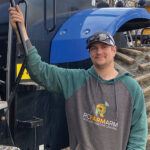Asteroid Incoming

Owen Orsak
Binscarth, Manitoba
“Plan A isn’t important. Plan B is important,” says Owen Orsak. “When was the last time Plan A worked in farming? Contingency planning is key. We need a strategy for when things don’t work.”
While Orsak can provide a long list of impacts, one big one for him is labour. He just hired a new employee at $30 per hour.
The issue, Orsak says, is that $30 won’t be enough to keep him long term. With four mines in the area, farms have to pay a lot more to compete for labour. He also knows of another farm in southwest Saskatchewan that offered $45 per hour and can’t get anyone to move to his remote location.
“Farm labour issues get talked about to death because they’re serious,” Orsak says.
So Plan B is to do more with fewer people. On the day we talked, Orsak was in the middle of harvest and also hauling 2023 canola to the nearby processing facility at Harrowby. “We used to have a 10 inch auger, tandem truck and small bins. Now I have a 13 inch auger, Super B truck, big bins and a camera. I can haul grain efficiently on my own.” The camera allows him to see where to move the truck while sitting in the driver’s seat.
Farmers also buy higher efficiency drills, bigger sprayers and combines – all so they can do more with less labour. Next is autonomy. “I’m excited for it, but we’re not there yet.”

Jonah McGrath
Leroy, Saskatchewan
How will farms harvest when all the older farmers are no longer able to work? Jonah McGrath’s dad and uncle are “out there every day busting their humps” and are the “backbone of the operation,” he says.
McGrath, like most farmers, runs a skeleton crew at peak times like harvest and seeding. “We can’t have any injuries or have anyone call in sick or go to the lake because it means a million dollar combine sits idle,” he says.
But finding people to work 18 days in the fall and 12 days in the spring gets harder and harder – even when farms are paying them more per hour than they’ve ever made in their lives, McGrath says.
“I go into the coffee shop to recruit and all the retired guys, the best of the best, are spoken for,” he says.
And as we lose these retired farmers, not enough new retirees or young people are entering the market to fill the void.
“You can’t put just anyone into the cab of combine,” he says.
One solution, McGrath says, is to reintroduce agriculture into public schools. Show students in towns and cities, students without an agriculture background, about the opportunities in agriculture and train them for a few key jobs, like how to run a combine.

Andrew De Roo
Fairlight, Saskatchewan
The De Roo family reviews the farm’s strategic plan every January, and they always discuss how markets and policy changes could affect the business. “Policy and markets always remain the top two concerns as we as farmers often have to adjust reactively not proactively,” De Roo says. With the strategic planning, they try to be as proactive as possible.
De Roo can think of numerous political and policy events that have affected their business. The federal government’s voluntary target to reduce nitrogen emissions by 30 per cent. “Unrealistic,” she says. Rail strikes that hurt Canada’s reputation as a reliable supplier. And high level disputes with China that always seem to create a trade disruption for canola.
By getting involved, farmers have a least some influence on policy outcomes.
“While these policy and market changes are frustrating, I believe it’s important to get involved – whether it’s local politics, commission groups or federal government.”
Her two terms with the Canadian Agricultural Youth Council ended in September, and she will be looking at the next opportunity.

Amanda and Curt Hazlett
Red Deer, Alberta
“Our biggest concern is drought,” says Amanda. “This is our third consecutive year of drought conditions.”
In 2023, they didn’t get a lot of rain, but “it came at just the right time,” Curt says.
Their barley yielded 150 bu./ac. in 2023, and “saved our bacon last year,” Amanda says. “This year, nothing is in the spotlight.”
No rains came when they needed it, and a lot of the moisture came as hail. However, after an extremely dry year, it was raining the day of this interview in late August – in the middle of harvest. “The irony is not lost on me,” Amanda says. “That would have been great in mid June.”
The Hazletts farm in an area where farmers, including them, use tillage to manage what is usually fairly heavy crop residue. “Field areas with lots of trash also tend to have way worse frost damage,” Curt says. But last fall, they forgot to cultivate two fields and this spring, those fields had fewer weeds and more soil moisture reserves. The results inspired them. “We are not likely to do any fall tillage this year,” Curt says. He is somewhat comforted by his observation that “as things are changing, spring frost seems to be less of an issue.”
If they lived farther south and had big flat fields, they would look into irrigation. “But our ground isn’t flat enough and our fields aren’t square enough for pivots,” Curt says, “so for us, the key is soil management practices to conserve moisture.”

Jennie Parsonage
Baldur, Manitoba
Weather volatility and market volatility are top of mind for Jennie Parsonage, who is part of three businesses – farming with her siblings, farming with her husband and his family, and an aerial spraying company.
Parsonage and her three siblings all have some sort of off-farm household income.
“We’ve got our fingers in different things,” she says, which takes some pressure off farm cash flow.
The aerial spraying business is somewhat more protected from weather volatility. “Generally, if the farm is doing well, the aerial spraying business is doing well, but the aerial business covers a wider geographic area, which makes it more consistent than the farm,” Parsonage says. “If the farm is dry, there is usually some area where yields are better and people are spraying more.”
On the farm she runs with her siblings, they grow six crops in general, and four in a given year. The crops are canola, soybeans, sunflowers, wheat, barley and oats. The family tries to forward-contract up to 50 per cent of historic yield, to take advantage of good price points before or while the crop is in production. “That way we’re not having to sell off the combine,” Parsonage says. They also keep good cost-of-production records so they always know the break even price for each crop.
They are looking at other contract tools, like call and put options to “systematically hedge,” but Parsonage knows of some farmers who tried this and eventually stopped.

Ryan Gauthier
Donnelly, Alberta
When Ryan Gauthier heard the question, there was a sigh, a long pause, then “so many things”, and another sigh.
For him the biggest issue, among many, is the cost of inputs compared to the price of grain. “This year is a prime example. Grain prices are down and nothing else went down with them,” he says.
“Some days it seems you need 100 bu./ac. wheat and 60 bu./ac. canola for it to pencil out.”
Gauthier recently hired a marketer to capture “relatively decent crop prices so we’re not leaving opportunities on the table.”
The farm also uses Cargill’s MarketSense program to keep a running total of expenses per field or per acre. The program helps them analyze each decision, showing how it affects profitability based on yield potential. “We know whether to throttle up or throttle down,” he says.
This is a family tradition. Even before the apps, Gauthier’s grandfather would do it old school, keeping a tally of expenses and profitability with his pencil and notebook. Gauthier sees great value in this practice, especially with margins tighter than ever.





